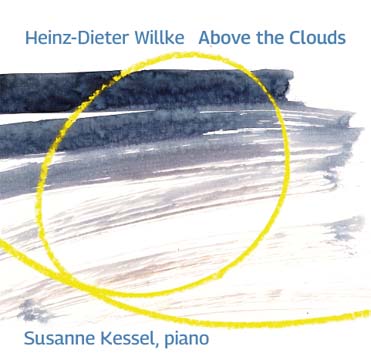
 |
Heinz-Dieter Willke – Above the Clouds |

Heinz-Dieter Willke – Above the Clouds
|
|
Der mit den Wolken tanzt Klaviermusik
Jede Wolke am Himmel ist einzigartig. Keine Schneeflocke gleicht der anderen. Egal wohin man blickt: überall individuelle Abweichungen kollektiver Gemeinsamkeiten. Je nach Blickwinkel sieht Eine sagenhafte Vielheit in der Einheit oder – je nach Perspektive – Einheit in der Vielheit entfaltet auch die Musik des 1956 in Düsseldorf geborenen Komponisten Heinz-Dieter Willke. Schon nach kurzer Zeit spürt man die permanente Entwicklung von Phrase zu Phrase. Nichts wird wiederholt, und doch hängt alles mit allem zusammen. Tonhöhen und -dauern bilden immer wieder andere Kombinationen und Abfolgen. Im Detail kehrt nichts wieder, und doch ähneln sich alle Töne, als seien es wahlweise dichte oder dünne, schwer oder leicht fallende Regentropfen. Oder Wolken, die mal ruhiger oder heftiger in immer wieder anderen Formen aufquellen, vom Wind getragen und modelliert, im Sonnenlicht schließlich aufgelöst und von neuen Dampf- und Nebelschwaden verdrängt werden.
Willke verklammert die fünf Sätze durch die gemeinsame Faktur sowie durch symmetrische Entsprechungen. Der zentrale dritte Satz ist mit Abstand der längste und bildet die zentrale Spiegelachse des Zyklus. Er besteht aus ruhigen 4/2-Takten im langsamen Tempo Halbe = 40 und dauert mehr als zwanzig Minuten. Gerahmt wird er von je zweimal zwei kürzeren Sätzen. Die Außensätze sind die schnellsten, und die Sätze II und IV haben exakt dasselbe Tempo Viertel = ca. 68. Während der langsame Mittelsatz durchweg mit Pedal zu spielen ist, das nur bei Klang- und Akkordwechseln kurz aufgehoben wird, werden die anderen Sätze nur stellenweise pedalisiert und so verzichtet der Finalsatz, der ausschließlich aus Achteln und Sechzehnteln marcato besteht, gänzlich auf Pedalisierung. Die Grunddynamik des gesamten Zyklus ist mezzoforte. Die Sätze II und V steigern sich analog zu ihrer erhöhten Motorik in obligaten 4/4- bzw. 6/4-Takten zu sffz oder fff. Dagegen bestehen die Sätze I und IV aus ständig wechselnden Großtakten zwischen minimal 3/4 und maximal 17/4 Länge. Dass Willke in seiner Musik immer wieder neue Varianten bildet, wird man sich beim Hören gerade auch in dem Moment bewusst, wenn sich die Rahmensätze I und V jeweils zu Beginn des letzten Drittels in Loops verfangen. Wie bei einer hängenden Schallplatte kreist plötzlich ein und dieselbe Figur mehrmals auf der Stelle, bevor es nahtlos weitergeht, als wäre nichts geschehen (NB 2, S. 11). Zwischen den behutsam verketteten Arpeggien und Arabesken wirken die Dasselbe Kompositionsprinzip verwendete Willke in seinem vierteiligen Zyklus Nexus Das kurze Klavierstück Allegro agitato (2018) schrieb Willke für das Projekt »250 piano pieces for Beethoven« der Bonner Pianistin Susanne Kessel, der auch sämtliche anderen Einspielungen auf dieser CD zu danken sind. Kessel hatte anlässlich von Beethovens 250. Geburtstag ebenso viele Komponistinnen und Komponisten unterschiedlicher Herkunft, Generation, Sparten und Stilistiken eingeladen, jeweils ein kurzes Klavierstück mit beliebigem Bezug zum Jubilar zu schreiben (NB 4, S. 13). Willke griff acht Takte vom Anfang der Durchführung des Kopfsatzes von Beethovens 5. Symphonie auf. Das Terzintervall des berühmten Klopfmotivs erfährt dort intervallische Stauchungen und Spreizungen zur kleinen Sekunde und Quarte. Willkes Stück beginnt mit dem taktweise ff repetierten Spitzenton as3, der als spitzer Marcato-Stachel während des ganzen Stücks immer wieder hervorsticht und mehrmals obsessiv repetierte SechzehntelOstinatofiguren initiiert. Beethovens motorisches Klopfmotiv aus drei auftaktigen Achteln mit anschließend fallender Terz wird nur ein einziges Mal flüchtig erkennbar. In der Mitte des Stücks lassen es Akzente, Pedalgebrauch, Crescendo molto espressivo und eine kurze Zäsur plötzlich scharf konturiert wie aus naturbelassenem Gestein gemeißelt erscheinen, bevor es sich sofort wieder in motorischen Kreisfiguren verliert. Rainer Nonnenmann
|
Dances with Clouds Piano music Every cloud in the sky is unique. No snowflake is the same as another. Wherever one looks, one sees individual variations of common characteristics. Depending on the viewpoint, one sees the whole or the particular. A fabulous diversity in unity, or – depending on the perspective – unity in diversity also unfolds in the music of composer Heinz-Dieter Willke, born in Düsseldorf in 1956. The listener detects, after a short time, a permanent development from phrase to phrase. Nothing is repeated yet everything hangs together. Pitches and durations are continually recombined in new orders. The resulting details never recur. The notes fall on the ear like raindrops, sometimes heavy, sometimes light, creating ever-changing forms like the clouds in the sky: sometimes dense, sometimes sparse, driven and shaped by the wind, to be ultimately vaporized by the rays of the sun.
The building-blocks of the five movements of Willke’s forty-minute long cycle Above the Clouds (2005) are fragments of a few bars length, differing in their rhythmic and intervallic structure. The characteristic initial constellations are organized in two lines, in bass and treble registers respectively, which are repeated in loops continually modified using techniques such as inversion, augmentation, transposition, or retrograde motion. Because the modification in one layer causes it to shorten slightly, the loops, differing in length, become increasingly out of phase with each other, producing ever-new constellations. Like a kaleidoscope, each rotation creates fresh chord sequences, rhythmic patterns and melodies. This almost vegetative growth is best observed in the slow third movement. Here the upper and lower voices begin in rhythmically synchronized parallel major ninths. Already, during the modified second phase, they have moved apart slightly. As the piece progresses, further phase-shifts bring about new chords and interval combinations, until, at the end, having turned full-circle, the voices are once again exactly synchronous (Ex. 1, p. 10). The five movements of Willke’s cycle are held together by their common compositional strategy and their placement in the symmetrical structure of the overall form. The mirror-axis of this symmetry is formed by the central third movement, more than twenty minutes long, which is in a calm 4/2 meter at a tempo of half = 40 and is framed by two fast movements on either side. The outer movements are the fastest, and movements II and IV have the same tempo: quarter = ca. 68. In the slow middle movement the pedal is used throughout, the frequent changes between harmonic complexes being precisely notated. In the last movement, which consists entirely of eighth and sixteenth notes played non legato, the pedal is not used at all. In the other movements sporadic pedal usage is indicated. The basic dynamic level for the cycle as a whole is mezzoforte. In movements II and V, which are in fixed 4/4 and 6/4 meter respectively, the dynamics increase to sffz or fff, underscoring the increase in rhythmic density. In contrast, in movements I and IV, with their meters continually changing in a range between 3/4 and 17/4, the mf dynamic remains nearly constant. In Willke’s music new variants are continually arising. The listener is made acutely aware of this in the outer movements, I and V, when, at about two thirds of the way through, the music suddenly becomes trapped in a loop. Like a gramophone record stuck in a groove, a fragment is exactly repeated several times before continuing seamlessly as if nothing had happened (Ex. 2, p. 11). Coming between the carefully interlinked arpeggios and arabesques, the effect of these exact repetitions is disturbing, since the basic mood of the cycle is one of an unruffled and unremitting flow, as if dancing freely and serenely in the clear air above the clouds. The combination of an unyielding forward-moving development and a firm adherence to the basic building blocks, gives the music a calming, even meditative quality. Depending on whether struck on the short strings of the upper register or on the longer, heavier strings of the bass register, the individual notes are shorter or longer, louder or softer, higher or lower. Each one has its own weight, and speaks for itself, far removed from the emotionalism and storytelling of the piano music of the past. The sounds simply appear and disappear, like breakers on a beach or clouds in the sky. Willke uses the same compositional principle in his four movement cycle Nexus (2008-2009). Unlike Schoenberg in his “Method of Composition with Twelve Notes Related Only to One Another”, he does not use the whole chromatic range all the time, but rather a limited selection thereof in different segments of the four movements (Ex. 3, p. 12). This results in the frequent recurrence of notes and in places octaves. Despite the high degree of dissonance produced by widely separated chromatic neighbouring notes, certain passages take on a characteristic harmonic colour, even a quality of modal tonality. Notwithstanding the compositional similarities to Above the Clouds, the four brief movements are very different in character. They are much shorter, in strict 3/2 or 2/2 time throughout, and in faster tempi. Rhythm, gesture, articulation and dynamics are freer and livelier. Tentative beginnings and fading endings, increasing and decreasing rhythmic density, crescendi and decrescendi give each movement a clearly defined overall form: like the interconnected networks of nerves, a “Nexus”, from which the various sensations, emotions, tensions and dramas of life emanate. The short Allegro agitato (2018) was Willke’s contribution to the project “250 piano pieces for Beethoven” instigated by the Bonn-based pianist Susanne Kessel, the interpreter of all the works on this CD. As part of the celebrations of Beethoven’s 250th birthday, she invited the same number of composers from different nations, different generations and different musical styles to write a short piece connected in some way to the great master (Ex. 4, p. 13). Willke’s piece is based on eight bars from the beginning of the development section of the first movement of the 5th symphony in which the falling major third of the famous opening motive is either contracted to a minor 2nd or expanded to a perfect 4th. It begins with a piercing repeated high a-flat, which is played ff marcato and dominates the piece until the last bar, mostly as part of obsessive semiquaver ostinato figures. Beethoven’s opening upbeat of three notes and subsequent falling third is heard in recognizable form only once. After a short caesura in the middle of the piece, it is led into by a crescendo marked molto espressivo with accents and precise pedal indications and emerges like a weathered stone statue before becoming once again embedded in a machine-like ostinato. Rainer Nonnenmann |
Above the Clouds bei Bandcamp |
|